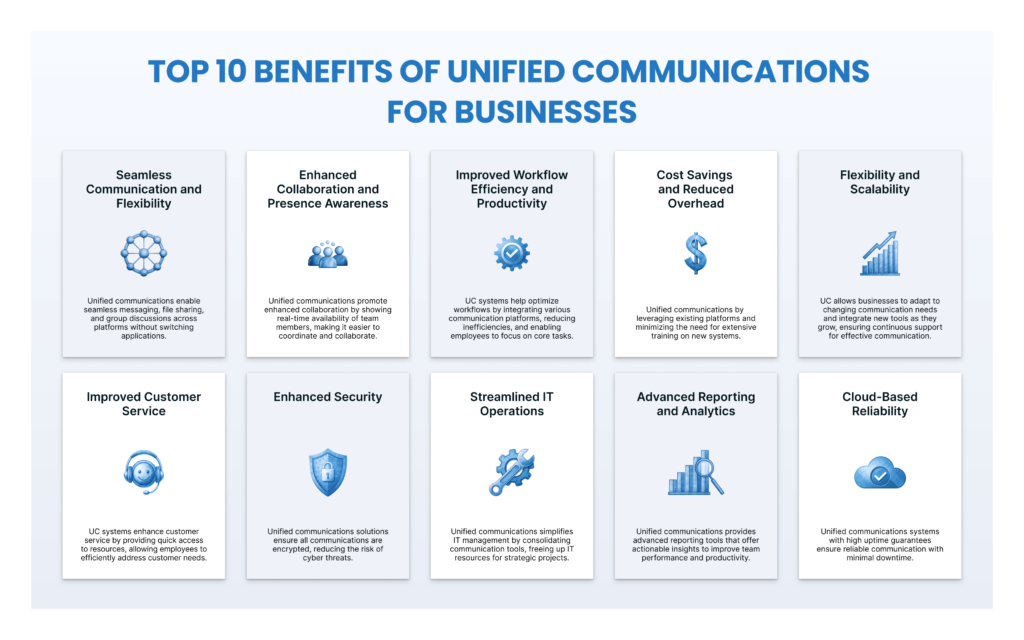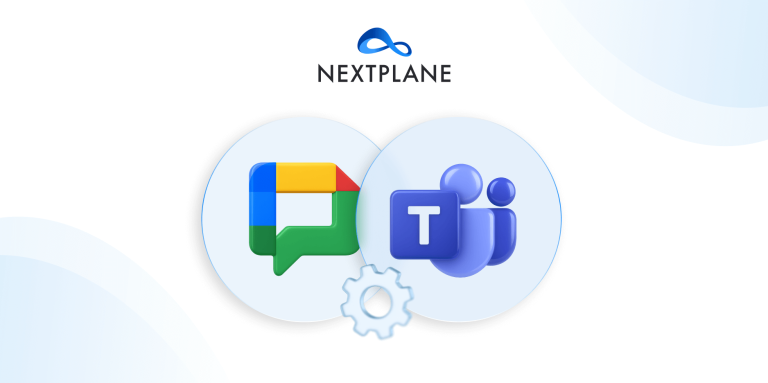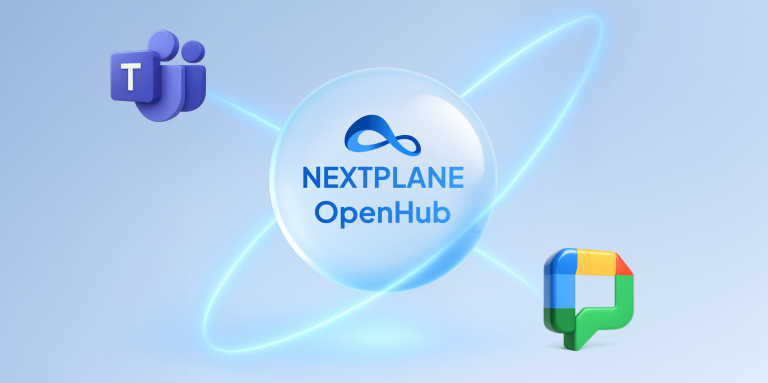10 Benefits of Unified Communications in Today’s Digital Workplace

Table of contents
- 1. What is Unified Communications?
- 2. The Benefits of UCaaS in a Multi-Platform Environment
- 2.1. 1. Seamless Communication and Flexibility
- 2.2. 2. Enhanced Collaboration and Presence Awareness
- 2.3. 3. Improved Workflow Efficiency and Productivity
- 2.4. 4. Cost Savings and Reduced Overhead
- 2.5. 5. Flexibility and Scalability
- 2.6. 6. Streamlined IT Operations
- 2.7. 7. Improved Customer Service
- 2.8. 8. Enhanced Security
- 2.9. 9. Accommodating Hybrid Work
- 2.10. 10. Interoperability: Bridging Diverse Systems
- 3. Implementing Unified Communications: Best Practices and Considerations
- 4. The Future of Unified Communications
- 5. Extending Unified Communication & Collaboration with NextPlane OpenHub
- 6. Why Unified Communications Is So Important for Business Success
Effective communication is paramount to success in today’s fast-paced, digital workplace. As organizations increasingly rely on multiple messaging and collaboration platforms, seamless integration and interoperability have never been more critical. This is where unified communications comes into play, offering a powerful solution to streamline workflows and improve productivity in a multi-platform environment.
What is Unified Communications?
Unified communications, also known as Unified Communications as a Service (UCaaS), combines phone, video conferencing, chat, screen sharing, and file management into a single, unified cloud-based system that is managed and monitored by a service provider.
UC becomes a strategic decision because it can address communications issues in new ways by delivering an integrated platform where all these applications are in use in a common — or unified — environment. It is a user-centric communication experience that helps bridge the gap between in-office workers, remote employees, and customers within a single application.
Gartner® defines UCaaS as “a cloud-delivered service that provides many of the same functions as premises-based unified communications (UC) solutions.” These solutions include standard communication tools and services such as instant messaging, audio, web and video conferencing, email, screen, and file sharing, plus mobility tools and collaborative apps that facilitate conversation and collaboration between remote employees to help keep them productive.

The Benefits of UCaaS in a Multi-Platform Environment
1. Seamless Communication and Flexibility
One of the primary advantages of unified communications is the ability to facilitate seamless communication across different platforms. Employees can send messages, share files, and participate in group discussions without the need to switch between multiple applications. This streamlined approach to communication reduces the time and effort spent navigating different tools, ultimately boosting productivity.
For example, imagine an organization using Microsoft Teams for internal communication and Cisco Webex for external collaboration with clients. Without unified communications interoperability, employees would need to constantly switch between the two platforms to communicate with both their colleagues and clients. This process can be time-consuming and disruptive to workflow. However, with interoperability, employees can communicate with internal and external contacts from a single interface, eliminating the need to juggle multiple applications.
Moreover, UC empowers your workforce with multiple connected communication channels in one solution. Even fully remote employees only need an internet connection to access your network and use all the features to be productive members of your team.
Siemens, a global leader in industrial automation, implemented a Unified Communications (UC) solution to address communication challenges across its worldwide operations. By integrating tools like voice, video, and messaging into a single platform, Siemens achieved seamless communication, enabling employees to collaborate efficiently across regions and time zones. This implementation led to a 25% increase in productivity, as employees could work more effectively without the disruptions caused by switching between multiple platforms. Additionally, Siemens reported a 20% reduction in communication-related costs, thanks to the streamlined system and reduced need for maintaining separate communication tools.The UC solution also supported remote work and flexible hours, which became particularly valuable during the COVID-19 pandemic. Siemens saw a significant improvement in project turnaround times, with teams able to collaborate in real-time, regardless of their location. This enhanced global communication capability improved operational efficiency and contributed to a more cost-effective working environment.
2. Enhanced Collaboration and Presence Awareness
Unified communications also promotes enhanced collaboration by enabling users to see their colleagues’ real-time availability and presence status, regardless of the platform they are using. This feature lets team members quickly identify who is available for a discussion or collaboration, eliminating the need for time-consuming back-and-forth communication to coordinate meetings or projects.
In a unified environment, an employee using Slack can easily see the presence status of a colleague using Microsoft Teams and vice versa. This real-time visibility into availability facilitates more efficient collaboration, as team members can quickly reach out to one another when they are available rather than wasting time trying to coordinate schedules across different platforms.
A global technology leader, IBM implemented a Unified Communications (UC) solution to enhance collaboration by integrating real-time presence awareness across multiple platforms, including Slack and Microsoft Teams. This integration allowed employees to instantly see their colleagues’ availability, regardless of the platform they were using, leading to a 30% increase in team productivity. By eliminating the need for time-consuming back-and-forth communication to coordinate meetings, IBM facilitated quicker and more efficient collaboration, enabling teams to reach out and engage immediately when colleagues were available.
Additionally, the UC interop solution reduced communication-related costs by 20%, as it streamlined the use of various platforms into a cohesive system. This approach minimized the need for multiple licenses and training on different tools, further reducing overhead costs. The enhanced real-time collaboration capabilities also accelerated decision-making processes, improving IBM’s overall operational efficiency.
3. Improved Workflow Efficiency and Productivity
Unified communications interop integrate various messaging and collaboration platforms between teams operating in different locations and time zones to help optimize workflows and reduce inefficiencies. Employees can access the information and resources they need from a unified interface, minimizing the need to switch between different applications. This streamlined approach to work enables teams to focus on their core tasks rather than wasting time navigating multiple systems.
A survey by Eastern Management Group has shown that companies adopting UC, on average, see a 52% improvement in workplace productivity and a 25% boost in operating profit. When your team knows precisely what communication platform to use for everything, they won’t spend countless hours searching emails and other apps.
Cisco, a global leader in networking and IT, implemented a Unified Communications (UC) solution to address inefficiencies caused by using multiple disparate communication platforms across its international teams. By integrating these platforms into a unified interface, Cisco streamlined its operations, allowing employees to focus on core tasks without switching between different systems. This integration led to a 52% improvement in workplace productivity and a 25% boost in operating profit as the company reduced operational complexity and enhanced collaboration across locations and time zones.
The UC solution also contributed to significant cost savings by minimizing the need for multiple licenses and reducing communication inefficiencies. Cisco’s experience highlights the powerful impact that a well-integrated UC system can have on workflow efficiency, productivity, and overall profitability.
4. Cost Savings and Reduced Overhead
Implementing unified communications can significantly reduce organizations’ costs. By leveraging existing investments in different platforms and enabling them to work together seamlessly, companies can avoid the expenses associated with migrating to a single, unified system. UC allows organizations to maintain their current infrastructure while reaping improved communication and collaboration benefits.
Moreover, UC can help organizations reduce the costs associated with training and support. By allowing employees to continue using the platforms they are already familiar with, organizations can minimize the need for extensive training on new tools and systems. This approach saves time and resources and helps ensure a smoother transition to a unified environment.
Shell, a global leader in energy, implemented a Unified Communications (UC) solution to address rising communication costs and inefficiencies caused by multiple disjointed platforms across its global operations. By integrating existing systems into a seamless UC environment, Shell avoided the high costs of migrating to new platforms while enhancing communication and collaboration across its workforce. This approach allowed employees to continue using familiar tools, significantly reducing the need for extensive retraining.
As a result, Shell reduced communication costs and overhead by 25% by streamlining support and minimizing the need for multiple licenses. The UC implementation not only reduced expenses but also improved operational efficiency, enabling Shell to maintain its existing infrastructure while enjoying enhanced communication across its global teams.
5. Flexibility and Scalability
Unified communications allows organizations to adapt to changing communication needs and preferences. As new platforms emerge or business requirements evolve, UC allows companies to integrate additional tools into their existing communication ecosystem easily. This scalability ensures that organizations can continue supporting effective communication and collaboration, even as their technology landscape changes.
Morgan Stanley, a global financial services leader, faced challenges in maintaining effective communication across its 60,000+ employees worldwide as new technologies and tools rapidly emerged. To address this, the firm implemented a Unified Communications (UC) interop solution that provided the flexibility to integrate various communication platforms into a single, scalable system. This UC solution allowed Morgan Stanley to seamlessly add new tools without disrupting its existing infrastructure, ensuring consistent and efficient communication across its global operations.
The implementation of this UC system resulted in significant cost savings and improved operational efficiency by reducing the need for expensive system overhauls and minimizing disruptions. Morgan Stanley’s ability to adapt to changing communication needs while maintaining a robust infrastructure highlights the value of a flexible and scalable UC solution in the fast-paced financial industry.
6. Streamlined IT Operations
When you examine your company’s communication methods, you may discover several solutions, each needing dedicated support and vendor management.
That means IT is responsible for deploying and effectively managing a UC platform across the organization. However, unified communications benefits IT staff by deploying applications in a common environment. IT teams achieve deployment either through on-premises appliances, VMs, or managed services within a public cloud. The ability to properly manage a range of communications applications is ideal — especially when it eliminates the need for employees to seek communications tools outside the control of IT.
For example, BYOD policies and shadow IT present ongoing challenges for IT, as control over network resources keeps slipping into the hands of end users. IT would welcome anything to level the playing field. With network communications management, UC is an improvement over enabling anyone to randomly choose communications tools that open the entire organization up to malware threats and data loss.
A UC interop solution helps free up IT resources from consolidating all communication in one platform. This time can be better spent innovating proactive strategies to grow your business and meet corporate goals.
Coca-Cola, operating in over 200 countries, faced significant IT challenges managing multiple communication platforms across its global network. The IT department was burdened with supporting various solutions, leading to inefficiencies, increased costs, and security risks due to shadow IT. To address this, Coca-Cola implemented a Unified Communications (UC) interop solution that consolidated all communication tools into a single, manageable platform. This move streamlined IT operations, reducing complexity and freeing up resources for innovation and strategic initiatives.
The UC platform also enhanced security by minimizing the use of unauthorized communication tools, ensuring all communications were secure and compliant with corporate policies. Additionally, Coca-Cola realized substantial cost savings by reducing the number of vendors and platforms requiring support. This case demonstrates the significant benefits of UC in streamlining IT operations, improving security, and achieving cost efficiencies in a large global enterprise.
7. Improved Customer Service
As cloud-based platforms gain traction, the rationale for integrating UC with the contact center is strengthening. While on-premises systems cannot support that option, many cloud providers now offer UC and contact center platforms on a joint basis. These platforms sell well because they share many common elements with premises-based tools, and with the cloud, they can be easily scaled into an integrated offering.
The introduction of UC capabilities in the contact center means that agents can more easily access resources outside the contact center while engaging with customers, so they can find the right resources within the organization on the fly and connect them as needed. Otherwise, agents must end the call, search for the right help, and then call the customer back — not a recipe for excellent customer service. With UC in place, agents have a better chance of a fast resolution, with only a single call necessary to assist the customer.
Alaska Airlines faced challenges in maintaining high customer service standards as it expanded, particularly with the need for quick issue resolution. The airline implemented a cloud-based Unified Communications (UC) solution integrated with its contact center to address this. This integration allowed customer service agents to access internal resources and collaborate with other departments in real-time while on a call with a customer, significantly reducing the need for follow-up calls and improving first-call resolution rates.
As a result, Alaska Airlines saw a 15% improvement in customer service productivity and reduced operational costs by streamlining communication processes. The ability to resolve most inquiries in a single call enhanced customer satisfaction and loyalty, demonstrating the powerful impact of integrating UC with contact center operations.
8. Enhanced Security
IT security is a core strength of UC since it natively integrates all the applications into a unified platform. Since all the applications interwork with each other, communications are more seamless as the platform doesn’t need to authenticate each incidence of usage.
Along the same lines, UC integration makes it easier for IT to apply a standard set of security policies across all communications applications. Tasks like security patches or compliance updates are also less complex to manage than if each application had its own set of protocols and parameters that required separate attention.
A less obvious benefit is reduced reliance on consumer-grade applications, which can introduce new security risks since they deploy outside the IT purview. When all collaboration applications work seamlessly on a common platform, workers have less reason to download standalone applications from the cloud.
Johnson & Johnson, a global leader in healthcare, faced significant security challenges due to the use of multiple communication platforms across its worldwide operations. The reliance on disparate systems made it difficult to enforce consistent security protocols, increasing the risk of data breaches and non-compliance with stringent healthcare regulations. Additionally, employees using unsecured, consumer-grade applications outside IT’s control further heightened security vulnerabilities.
Johnson & Johnson implemented a Unified Communications (UC) solution to address these issues by integrating all communication tools into a secure platform. This allowed the IT department to apply standardized security policies across the entire organization, simplifying the management of security patches, compliance updates, and user authentication. By centralizing communications, the company also reduced the need for employees to use unapproved applications, thereby minimizing potential security risks.
As a result, Johnson & Johnson significantly enhanced its security posture, ensuring better protection of sensitive data and easier compliance with regulatory standards. The unified platform not only streamlined IT management but also reduced the frequency of security incidents, demonstrating the critical role of UC in safeguarding enterprise communications.
9. Accommodating Hybrid Work
Telephony vendors developed UC as a successor to private branch exchange, which has been in decline for some time. While these first-generation tools brought new value to enterprises looking to stay current with technology, today’s cloud-based UC offerings are even more beneficial. Remote work sharply increased due to the COVID-19 pandemic but is challenging to support with premises-based technology.
The new remote work norm has pushed IT to adopt technologies that support a decentralized workplace, positioning UCaaS as an especially handy technology for enterprises. For disparate team members to collaborate effectively, they need a consistent set of tools and applications. Remote workers use a variety of endpoints across a variety of settings, and UC offers the same UX as in the office, making it much easier to collaborate, regardless of location.
PwC, a global leader in professional services, faced significant challenges during the COVID-19 pandemic. The shift to remote work exposed the limitations of its premises-based communication systems. The firm needed a solution to support its decentralized workforce and ensure consistent and effective communication across its global operations.
To address this, PwC implemented a Unified Communications as a Service (UCaaS) solution, which provided a cloud-based platform for all communication needs. The UCaaS platform allowed PwC to offer employees the same user experience (UX), regardless of their location or device, enabling seamless collaboration between remote and in-office workers. Integrating telephony, messaging, video conferencing, and other tools into a single platform made it easier for global teams to stay connected and productive in a hybrid work environment.
As a result, PwC achieved seamless collaboration, improved productivity, and the scalability needed to support its growing workforce during the pandemic and beyond. The consistent communication experience across all work environments demonstrated the effectiveness of UCaaS in accommodating hybrid work and maintaining operational efficiency.
10. Interoperability: Bridging Diverse Systems
One of the foremost challenges in deploying UC is ensuring interoperability among different UC components and vendor solutions. With organizations often using a mix of communication tools from various providers, achieving seamless integration can be daunting. Interoperability issues can lead to fragmented communication, diminishing the effectiveness of the UC system. Organizations must carefully select UC solutions that adhere to industry standards and offer robust integration capabilities to ensure a cohesive communication ecosystem.
Airbus, a global aerospace leader, faced significant challenges with interoperability due to the diverse communication tools used across its global operations. The company’s reliance on multiple systems from different vendors led to fragmented communication, making collaboration across departments and locations difficult and inefficient. This fragmentation not only affected productivity but also posed security and compliance risks.
To address these issues, Airbus implemented a Unified Communications (UC) solution specifically designed to bridge diverse systems. The chosen UC platform adhered to industry standards and offered robust integration capabilities, enabling seamless integration of tools like Microsoft Teams, Cisco Webex, and legacy systems. This integration allowed Airbus to create a cohesive communication ecosystem where all channels worked seamlessly, improving coordination and project execution.
As a result, Airbus experienced enhanced productivity, with teams able to collaborate more effectively without the disruptions caused by incompatible systems. The unified approach also strengthened the company’s security and compliance by ensuring consistent communication protocols across all platforms. This case highlights the critical role of interoperability in creating an efficient and secure communication environment in large, complex organizations.
Implementing Unified Communications: Best Practices and Considerations
While the benefits of unified communications are clear, implementing a UC solution can be a complex and challenging process. Here are some key considerations and best practices for deploying UC in your organization:
1. Develop an Adoption Lifecycle Plan
Start with an adoption lifecycle plan to achieve a truly connected workforce. According to a Verizon-sponsored survey by Wainhouse Research, companies that began this way increased speed and reduced IT costs and risks.
2. Address Security Concerns
Consider how you will secure access to video conferencing and other tools. What are the platform’s security features? Ensure your UC solution provides robust security measures to protect your organization’s sensitive information.
3. Evaluate Network Architecture
Assess your current network layout and determine if the proposed network has enough redundancy to support a UC solution. This may involve upgrading your existing infrastructure to ensure optimal performance.
4. Consider Managed Services
Bringing in a managed service provider (MSP) can save companies time and money by allowing IT to focus on other projects and reduce the time and expense of filling potential skills gaps. According to Wainhouse Research, 47% of vendor-led programs were successful, compared to 33% of do-it-yourself programs.
5. Focus on User Experience and Training
Ensure your UC solution provides a seamless user experience across all devices and platforms. Invest in comprehensive training programs to help employees maximize the new tools and features.
6. Integrate with Existing Systems
To maximize efficiency and productivity, look for UC solutions that can easily integrate with your existing business applications, such as customer relationship management (CRM) systems.
7. Plan for Scalability
Choose a UC solution that can grow with your organization. This will allow you to add new features and users as needed without significant disruption or cost.
The Future of Unified Communications
As the workplace continues to evolve and remote work becomes increasingly prevalent, the importance of unified communications will only grow. By embracing UC, organizations can future-proof their communication infrastructure, ensuring that their teams can collaborate effectively, regardless of their platforms or locations.
Moreover, as new communication and collaboration tools emerge, UC will play an increasingly critical role in enabling organizations to integrate these tools seamlessly into their existing infrastructure. This includes integrating artificial intelligence (AI) and automation technologies, which can further enhance productivity and streamline workflows.
Some emerging trends in unified communications include:
1) AI-Powered Assistants and Chatbots
AI-powered assistants and chatbots transform how businesses handle customer service and internal support. These technologies leverage natural language processing (NLP) and machine learning algorithms to understand and respond to user inquiries, automate routine tasks, and provide instant assistance.
Customer Service:
Chatbots can handle a variety of customer interactions, from answering frequently asked questions to processing transactions. For example, an AI-driven chatbot integrated into a company’s website can instantly respond to customer queries about product details, order status, or support issues, reducing the need for human intervention and improving response times.Internal Support:
In internal support scenarios, AI assistants can help employees with IT issues, HR inquiries, or operational questions. They can guide users through troubleshooting steps, provide information about company policies, or even automate repetitive tasks like data entry and scheduling.
2) Advanced Analytics and Machine Learning
Advanced analytics and machine learning are providing deeper insights into communication patterns and employee productivity. By analyzing data from various communication channels, organizations can identify trends, optimize workflows, and make data-driven decisions.
Communication Patterns:
Advanced analytics and machine learning are providing deeper insights into communication patterns and employee productivity. By analyzing data from various communication channels, organizations can identify trends, optimize workflows, and make data-driven decisions.Employee Productivity:
Advanced analytics tools can track metrics like response times, engagement levels, and task completion rates. By correlating these metrics with communication data, organizations can identify high-performing employees, detect productivity issues, and implement targeted training or support.
3) Enhanced Video Conferencing Capabilities
The integration of virtual and augmented reality (VR/AR) into video conferencing is creating more immersive and interactive meeting experiences. These technologies enhance collaboration by providing a more engaging and realistic environment for virtual meetings.
Virtual Reality (VR):
VR can simulate a physical meeting room or collaborative workspace, allowing participants to feel as if they are in the same room despite being geographically dispersed. This can be particularly beneficial for brainstorming sessions, training workshops, or team-building activities.Augmented Reality (AR):
AR overlays digital information onto the real world, enabling users to interact with virtual objects during a video call. For example, AR can be used to visualize 3D models, annotate documents, or share interactive presentations during meetings.
4) Improved Mobile Experiences
With the rise of remote and on-the-go work, enhancing mobile functionalities in unified communications solutions is crucial. Modern UC platforms are increasingly focusing on providing robust mobile experiences to ensure that employees can stay connected and productive from anywhere.
Mobile Optimization:
Features such as push notifications, mobile conferencing, and offline access are becoming standard. These capabilities allow users to receive real-time updates, participate in video calls, and work on documents even when they are not connected to the internet.Unified communications solutions are being optimized for mobile devices, with features such as responsive design, mobile-friendly interfaces, and streamlined workflows. This ensures that users can access all necessary communication tools and resources on their smartphones or tablets.Mobile-First Features:
Features such as push notifications, mobile conferencing, and offline access are becoming standard. These capabilities allow users to receive real-time updates, participate in video calls, and work on documents even when they are not connected to the internet.
5) Greater Emphasis on Security and Compliance
As communication technology evolves, there is an increasing focus on implementing advanced security measures and ensuring compliance with regulatory standards. Protecting sensitive information and maintaining privacy are top priorities for organizations.
Advanced Security Measures:
Unified communications platforms incorporate end-to-end encryption, secure authentication methods, and real-time threat detection to safeguard communication data. These measures help prevent unauthorized access, data breaches, and cyberattacks.Compliance Features:
UC solutions are being designed to comply with various industry regulations and standards, such as GDPR, HIPAA, and CCPA. This includes features like data retention policies, audit trails, and compliance reporting to ensure that organizations meet legal and regulatory requirements.
Extending Unified Communication & Collaboration with NextPlane OpenHub
In today’s global business environment, interoperability across multiple collaboration platforms is crucial for the success of geographically dispersed teams. As highlighted in Harvard Business Review’s “Global Teams That Work,” effective management of such teams requires seamless communication and integration of different tools. The SPLIT framework emphasizes choosing the right technology to reduce social distance and enhance collaboration.
NextPlane OpenHub enables seamless communication and collaboration across a wide range of messaging and collaboration platforms, including Microsoft Teams, Zoom, Slack, Cisco Webex, and more. Organizations can easily connect their disparate communication tools, creating a unified, federated environment that promotes productivity and efficiency.
Key features and benefits of NextPlane OpenHub include:
- Universal Channels: Create cross-platform messaging system for seamless conversations.
- Direct Messaging: Enable cross-platform private chats.
- File Sharing: Share documents across platforms effortlessly.
- Presence Synchronization: View real-time availability across platforms.
- Centralized Administration: Manage all collaboration from a single interface.
OpenHub breaks down communication barriers, allowing organizations to maximize their investment in collaboration technology regardless of their partners’ preferred platforms. It enables seamless interaction between users of different platforms, ensuring inclusive and efficient communication across the entire business ecosystem.
Why Unified Communications Is So Important for Business Success
Effective communication and collaboration are essential for any business in today’s digital age. Unified communications offer a powerful solution for bridging communication gaps, improving productivity, and enhancing the overall employee and customer experience.
By implementing a comprehensive UC strategy, organizations can:
- Streamline communication and collaboration across multiple platforms
- Increase productivity and efficiency through improved workflow management
- Reduce costs associated with maintaining multiple communication systems
- Enhance customer service and satisfaction
- Improve security and compliance measures
- Future-proof their communication infrastructure for continued growth and innovation
As businesses adapt to the changing work landscape, including the rise of remote and hybrid work models, unified communications will play an increasingly critical role in ensuring seamless operations and maintaining a competitive edge.
Organizations should carefully evaluate their needs, choose the right unified communications solution, and develop a comprehensive implementation strategy to reap the full benefits of UCaaS. By doing so, they can unlock the full potential of their workforce, drive innovation, and position themselves for long-term success in an increasingly digital and interconnected world.
If collaboration interoperability sounds like the solution to connecting your global teams, discover Teams integration opportunities that NextPlane offers.





